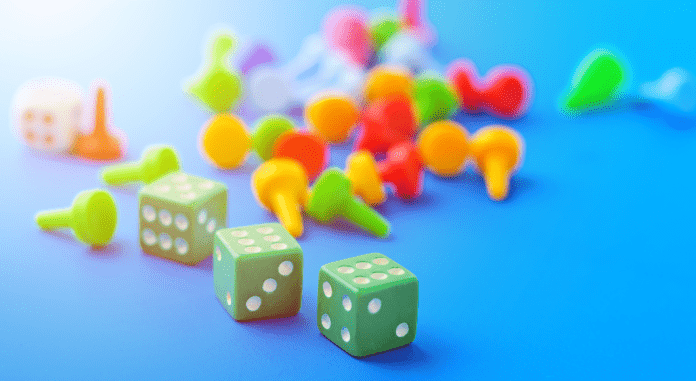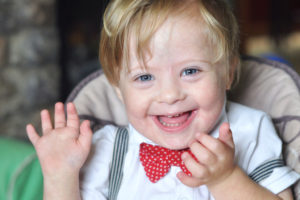You can learn a lot about parenting from books, blogs (*wink, wink), professionals, and more. Some of parenting, though, is learning by experience or, sometimes, by sheer accident. This is one of those stories. Recently, we started playing some games with our kids (ages 5.5, 4, and 2.5). We started with the age-appropriate classics, Chutes and Ladders, Candyland, and Lucky Ducky. These games are wonderful for young children.
Then, they saw the plethora of other games we had in our storage coffee table and asked to play them. At first, I said no. I didn’t want the pieces to end up all over the place and get lost. And I knew the directions were above their understanding so I didn’t think it would be worth it. They kept asking, though, and eventually we got out Battleship. THEY LOVED IT. No, they don’t understand the given directions, but they love placing the ships on the board and then putting the red pieces in them to sink them. It kept their attention way longer than most of their toys do.
They started wanting to play more games and I started letting them. They’d play with one and then ask for another. This went on for HOURS some days. I’d either just let them free play with the game pieces or alter the directions to something more age-appropriate. For example, to play Guess Who, I had them pick out a picture card and then flip up the people on the board until they found the match. Matching is a skill little ones need to learn and practice. So, they were having fun AND learning! There are so many benefits of playing board games with preschoolers. Over the last few weeks that I’ve been letting them play these games, they’ve:
-
watched TV much less (they don’t even ask as often),
-
had more imaginative play,
-
practiced matching, colors, numbers, building, sharing, etc., and
-
my husband and I have had more quality time playing with them.
Best Board Games for Kids:
Here is a list of the games my kids have been playing with descriptions of how they “play” them.
Yahtzee/Word Yahtzee: Gideon likes to play school with this one. He uses the timer to tell his students (stuffed animals or us) when it’s time to go to the playground and to go home. He uses the scorecards to check his students in and give them grades. He stores his teacher supplies in the cup that comes with it to roll the dice. He rolls the dice, matches the dots, and lines them up. He’s spent hours of free play with this one.
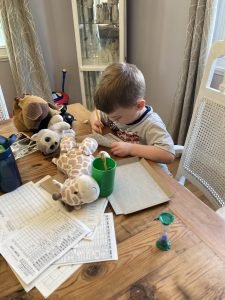
Dominos: Gideon and Phoebe both like to play with these. They’ve used them to build roads for their cars. Building towers and shapes are also fun. Gideon can also match up the colors and count the dots.
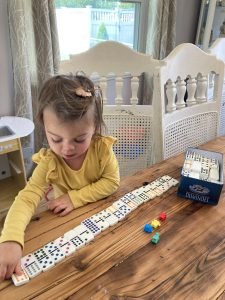
Blokus: They both love playing this one too, mostly as free play. They mostly build shapes and designs with the pieces. I’ve also had Gideon sort the colors. The last time he was playing this one, he realized that there were light lines on the board marking where the pieces go for storage (this is the travel version). He then started matching the pieces up to the spot they actually go in. This has been a great free play and learning game!
The Game of Life: Gideon calls this “the racecar game.” He likes to put the people in the cars (fine motor skills) and drive them around the board. He also plays with the money, pretending he’s selling things in a store.
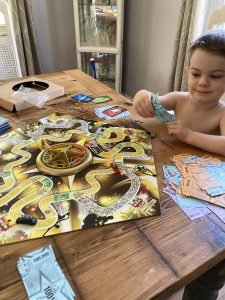
Twister: This one is great for color recognition. I’ll spin the spinner, and then they have to hop onto a circle of that color. You can also play this one pretty close to the given directions. They don’t understand right and left just yet, but they do know hand and foot, so we can play that way for now.
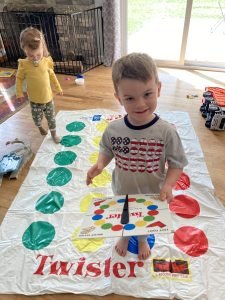
Playing Cards: Gideon plays with these as free play. I’m honestly not sure what he does with them exactly, but he enjoys playing with them. I’ve also had him match up shapes, colors, and numbers.
Sorry: Another great one for color recognition and free play. The game board has a home spot for each color, so Gideon can sort the colored pieces and put them where they should go. Then, he plays with the cards and moves the pieces around the board.
Chess/Checkers: We have a gameboard that comes with both the chess pieces and checkers. Both kids do free play with these. They like to set up the chess pieces on top of the checkers. Building stacks with the checkers is also fun. I recently Googled, “What age can a child learn chess?” The answer really surprised me. It is suggested to start around age 7 or 8, but some kids have learned as young as age 4! So, I think it’s a great precursor to let him play with and get familiar with the pieces before actually learning the game. He asks me the names of the pieces and already observed that each color has the same pieces. Wow!
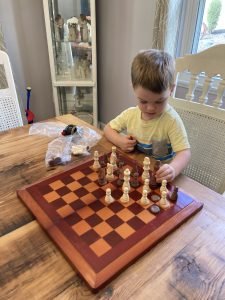
Otrio: Yet another game that’s great for color recognition, patterns, and free play. Gideon can sort the colors, make patterns with the different size rings, and make designs on the board!
As you can see, letting my kids play with these games has provided lots of learning and play experiences. I always make them play on the dining room table (other than Twister, of course). This helps to keep track of the pieces a little easier and would help keep the pieces away from a little one, if needed. Gideon and Phoebe know that if a piece falls on the floor, they need to pick it up right away so it doesn’t get lost. We do game play a lot while Ezra (2.5) is napping since he’s still learning the rules.
Another way to keep track of the pieces and not make too much of a mess is to only let them have one game at a time. The kids cannot access the games themselves, so they have to ask me to play. If they want another one, they have to clean up the current one first and we put it away as we get another one out.
Letting your children play with games above their age level provides unique learning experiences. It also gives them an opportunity for creative free play!
If you have other games at home, comment the name of the game and I’ll let you know my ideas for how your young children can play with it!



